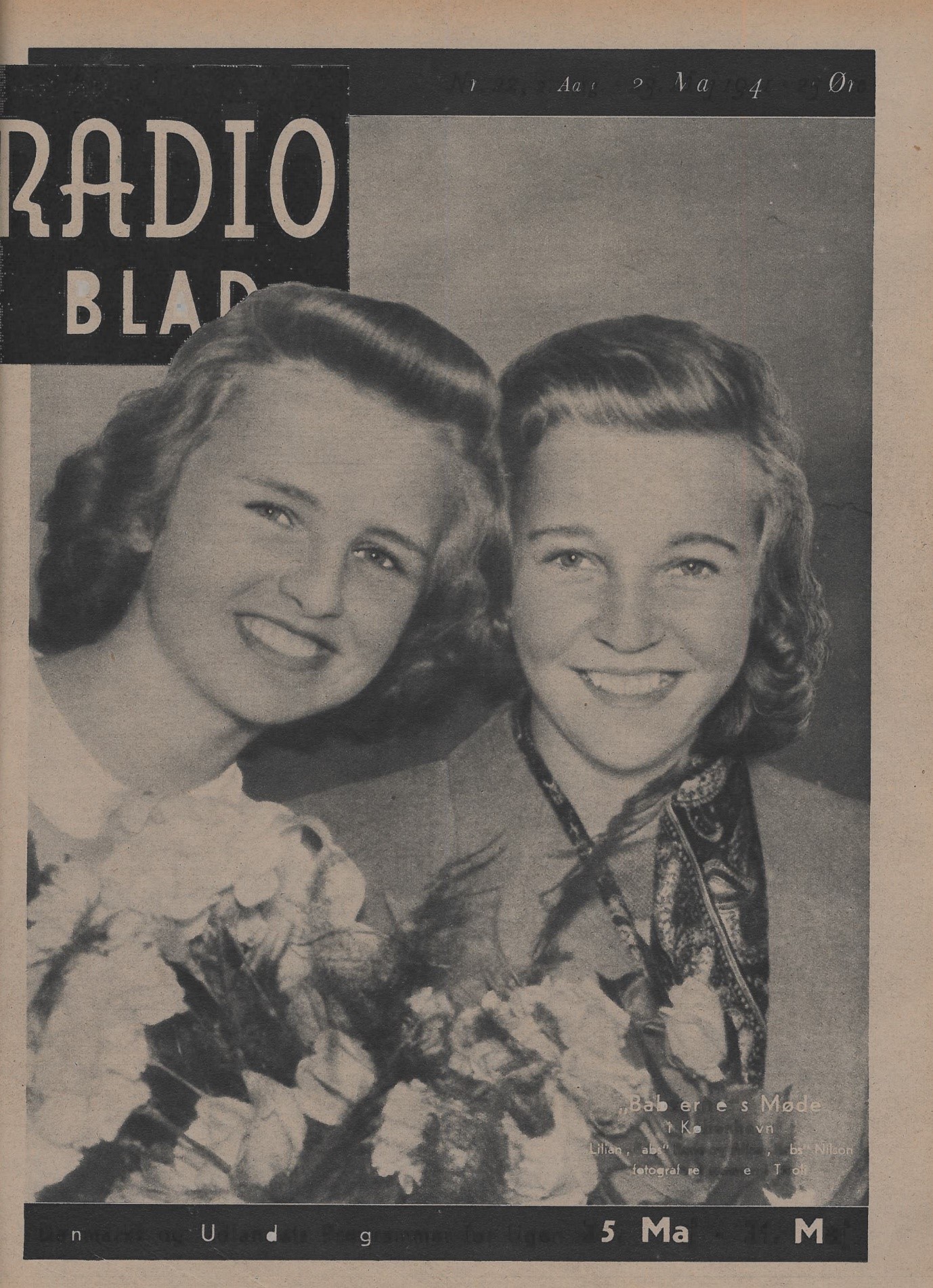Babsernes storhedstid – om idoler og jagten på deres lokale sidestykker i 1940’erne
Av Bertel Nygaard, Aarhus universitet
Hvis vi nu skal have flere Alice ’Babs’ Nilsson’er gaaende rundt herhjemme, saa garanterer jeg ikke for, hvad der kan ske i Hjemmene. Tænk paa, hvad det vil sige, naar den Epidemi først faar smittet Skolepigerne rigtigt. Oh boy! Oh boy! Swing it, Hr. Lærer!
Sådan advarede ’Dagbogsmandens’ klumme i flere konservative danske provinsaviser den 25. april 1941. Det handlede om ung kvindelig idoldyrkelse. I det forår blev ungdommen i det tysk besatte Danmark nemlig grebet af ’Babs-feber’. I marts fik den svenske film Swing it, Hr. Lærer (på svensk Swing it, magistern, 1940) dansk premiere, og den 17-årige hovedrolleindehaver Alice ’Babs’ Nilson blev tidens nye sangidol.
Musikskribenter var benovede over hendes talent og fremhævede især hendes evne til at forbinde tidens nye afroamerikansk forankrede swingmusik med en umiskendelig nordisk tone. Og fordi hun gjorde dette som ung, fremtrædende kvinde udtrykte hun en åbenhed over for ikkehvid kultur, kvindelig handlekraft og ung selvstændiggørelse, som langtfra alle brød sig om. Under verdenskrigen krævede både nazisterne og deres modstandere alvorlig disciplin af ungdommen, så alene det at more sig som ung kunne blive mere end blot eskapisme. Det kunne også blive en udøvelse af et element af frihed og lyst.

Bild 1. Lindgreen som Babs i Billedbladet, 06-05-1941
De kulturhistoriske udfordringer studerer jeg nærmere i det seneste nummer af Scandia – tidskrift för historisk forskning. Her vil jeg fortælle lidt mere om ’Dagbogsmandens’ anledning til at frygte for de mange unge babser rundt om i de danske hjem. Et centralt og karakteristisk element i dette stykke ungdomspopulærkultur var nemlig de omfattende bestræbelser på at udpege lokale sidestykker til større udenlandske idoler.
Som ungt musik- og filmtalent blev Alice Babs selv først sammenlignet med Hollywoodstjerner som Judy Garland og Deanna Durbin. Men i løbet af få uger var det Babs selv, det var forbillede for tusinder af purunge danske kvinder. Danske medier indledte en intens søgen efter ’den danske Alice Babs’. Blot et par uger efter filmpremieren stod det københavnske dagblad B.T. og Nordisk Films Kompagni bag en stor talentkonkurrence, hvor mere end 300 unge kvinder optrådte med mikrofonsang, gerne med frisurer, kjoler og dansetrin, der mindede om Alice Babs i Swing it, Hr. Lærer. Vinderen blev den 17-årige, klassisk sangtrænede danselærerdatter Solvejg Lindgreen, som derpå blev præsenteret som stjerne i egen ret. Bladene bragte reportager fra både hendes koncerter og privatliv.
Men Solvejg Lindgreen fik ikke titlen for sig selv. Mens konkurrencearrangørerne langsomt vurderede de mange håbefulde danske ’babser’, udnævnte ugebladet Det ny Radioblad ganske enkelte sit eget bud på en rigtig dansk Babs. Det var den 15-årige Lilian Rune, lillesøster til den allerede etablerede swingsangerinde Inge Lise Rune. Også Lilian ’Babs’ blev lanceret som stjerne gennem koncerter, grammofonindspilninger og interviews.

Bild 2. Babsernas møde - Det ny Radioblad, 1941
Og de to var blot begyndelsen. I de næste uger fulgte en lang stribe af lokale Babs’er: Brønshøjs Babs (Gunhild Dahlberg), Odenses Babs (Minna Nissen), Aalborgs Babs (Alice Bøgh) og talrige andre. Alt imens både Solvejg Lindgreen og Lilian Rune kastede storbyglans og svensk medieret amerikanskhed over danske provinsbyer, når de turnerede rundt som de fremmeste babser.
Alt dette var tidlige udtryk for fankultur og idoldyrkelse, som har udviklet sig videre frem mod vores egen tid kendisser. Men det, at man så målrettet udpegede lokale sidestykker til større internationale navne, var samtidig efter alt at dømme en relativt tidsbunden form. Op gennem 1940’erne og begyndelsen af 1950’erne viste sig mindst tre fremtrædende bud på den danske Bing Crosby, heriblandt den unge Gustav Winckler. I 1951 blev den 17-årige Laila Rasmussen kåret som den danske Doris Day. Fem år senere blev skuespilleren Klaus Pagh præsenteret som den danske James Dean i forbindelse med filmen Ung leg. Siden fulgte den danske Tommy Steele (Flemming ’James’ Rasmussen), den danske Elvis Presley (Otto Brandenburg og flere andre), de danske Beatles og de danske Rolling Stones. Og så videre.
Ofte var sidestykke-erklæringerne en målrettet markedsføringsstrategi – som i den danske Alice Babs’ tilfælde. I andre tilfælde opstod sammenligningen mindre målrettet blandt publikum eller i pressen. Men uanset de varierende former bidrog disse idolsidestykker til at bringe det fjerne nærmere og at gøre det nye eller uvante bekendt – uden nødvendigvis at efterligne forbilledet direkte.
Langt de fleste erklærede hjemlige sidestykker gik ganske vist i glemmebogen igen lige så hurtigt, som de var trådt offentligt frem, men alle dem, der fastholdt en offentlig karriere, rystede hurtigt sidestykke-betegnelserne af sig for at videreføre karrierer i egen ret og under eget navn eller kunstnernavn. Sidestykkebetegnelserne var således i alle tilfælde flygtige, men dog meget udbredte i lanceringsfasen.
Som helhed udtrykte denne jagt på sidestykker en bemærkelsesværdigt åbent vedkendt leg med modsætningerne mellem det enkelte idols fremragende status, dets samlebåndsagtige reproducerbarhed og det, det hjemlige sidestykke vil kunne tilføje af lokalt særpræg til det udtryk, der låntes fra originalen.
Lige så betydeligt er det, at fænomenet stort set forsvandt efter kåringerne af Beatles- og Stones-sidestykkerne. Fra slutningen af 1960’erne lancerede nye musiknavne inden for både den kunstnerisk ambitiøse eller autenticitetssøgende rock og den mere åbenlyst kommercielle mainstream-pop sig uden sidestykke-påberåbelser. De nye former for live-efterligninger af døde eller dyre musikidoler, som er vokset frem siden – fra Elvis-impersonators til jam bands, der specialiserer sig i at efterligne kendte bands som The Beatles eller U2 – kan godt hævdes at videreføre nogle af de samme præferencer for det velkendte. Men de adskiller sig fra den gamle sidestykkejagt ved netop at være efterligninger. Sidestykkejagten synes således at være et historisk afgrænset fænomen, der i denne del af verden efter alt at dømme trådte særligt markant frem omkring midten af det 20. århundrede.





